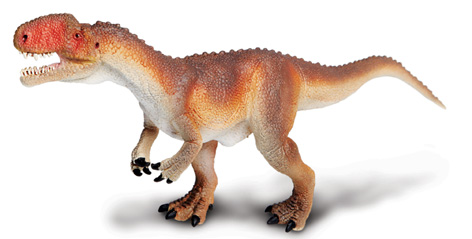A Review of the Wild Safari Dinos Monolophosaurus Model
Monolophosaurus Dinosaur Model Reviewed
Recently introduced into the varied and diverse Wild Safari Dinosaurs and Prehistoric Life model series is this replica of the Mid Jurassic predatory dinosaur from North-west China called Monolophosaurus (M. jiangi).
Although, not the biggest meat-eating dinosaur from China, the discovery of Monolophosaurus has helped palaeontologists to develop a better understanding of how theropod dinosaurs evolved and radiated into a number of different Super-Families dominating ecosystems and becoming the foremost land-based predators for next 110 million years or so.
Monolophosaurus
Monolophosaurus means “single crested lizard”, it was named in 1993 and this new dinosaur model from the design team of Safari Ltd amply demonstrates how this dinosaur got its name. There is a large ridge of bone running from the tip of the snout to just before the eye-sockets, this formed a substantial crest, the function of which remains unknown.
Although an integral part of the skull, this crest was largely hollow and it being used in head-butting contests between rivals has been ruled out as the crest is too weak to withstand the stresses of such impacts. It was probably used as a visual signalling device between mature individuals and in recognition of this theory, the designers at Safari Ltd have painted their crest with a splash of bright red.
The Wild Safari Dinosaurs Monolophosaurus Dinosaur Model
Picture credit: Safari Ltd
Wild Safari Dinos Monolophosaurus
A common mistake made by dinosaur model collectors is to assume that Monolophosaurus is closely related to the dinosaur known as “Double crested lizard ” – Dilophosaurus. When we compare the Monolophosaurus replica with the Wild Safari Dinosaurs Dilophosaurus model, there is some resemblance, both dinosaurs had distinctive crests, but this similarity is only superficial. Although, the exact taxonomic position of Monolophosaurus remains open to debate, most palaeontologists believe that this dinosaur is a primitive member of the Tetanuran group of meat-eating dinosaurs and as such it is more closely related to Allosaurus than it is to Dilophosaurus.
Dilophosaurus and Monolophosaurus Compared
Picture credit: Everything Dinosaur
Known from a single fossil specimen of an adult animal, this dinosaur grew to lengths of around five and a half metres. With a total length of 21 centimetres, we at Everything Dinosaur estimate that this replica is in approximately 1:26 scale. The fossilised skull bones of Monolophosaurus represent one of the best preserved theropod dinosaur skulls found to date.
This model is very well balanced and gives the impression of a strongly built dinosaur. The tail makes up around half the length of the model. Although the actual size of this dinosaur’s tail is unknown, as when the strata containing the fossils of Monolophosaurus was being excavated it was discovered that almost the whole of the tail had already weathered out of the rocks and been eroded away.
The model makers at Safari Ltd have once again done a fantastic job when it comes to painting. Even individual teeth in the long, narrow jaws have been carefully picked out. The body and flanks are painted a reddish brown with a slightly lighter tan coloured line merging into a stone coloured underside.
The skin texture is excellent, although no skin impressions of Monolophosaurus have been found, this dinosaur has been given a hide comprising of irregularly shaped and sized dermal scales. There is a single row of raised scales that run from the back of the head to almost the end of the tail giving this meat-eating dinosaur a striking, formidable appearance, very appropriate really as it was probably the apex predator in its environment.
Carnegie Prehistoric Animal Replicas and Wild Safari Dinos: Safari Ltd. Wild Safari Prehistoric World Models and Figures.
This is an exciting addition to the Wild Safari Dinosaurs model range made by Safari Ltd and it is always a pleasure to see an important fossil specimen interpreted as a prehistoric animal replica.



